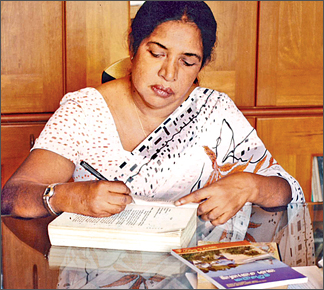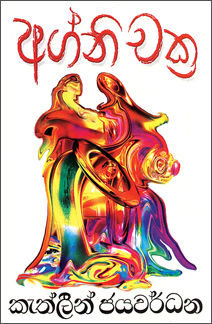Milieu defining nature of Agni Chakra (The Circles of fire)
By Ranga Chandrarathne
|

Kathleen Jayawardene
|
 One of the prominent characteristics of a novel is that it depicts
the time, personages that dominated the era as well as the
socio-economic changes akin to that period which had a marked bearings
on the lives of the population at large. One of the prominent characteristics of a novel is that it depicts
the time, personages that dominated the era as well as the
socio-economic changes akin to that period which had a marked bearings
on the lives of the population at large.
This milieu defining nature is not confined to fiction alone but is
also valid vintage point to study the merits and demerits of other forms
of art such as cinema and drama. Another important aspect of literary
creation is the deeper analysis of human psyche and the graphical
depiction of unique mentalities of divergent characters which represent
not only different shades of opinions but also diverse strata of
society, the prevalent class structure and the ethos of the society at
large. A deeper analysis of humanity in a literary creation, apart from
defining the milieu in which it is written, is a characteristic which
ensures universal appeal for such creation superseding the cultural and
at times, linguistic barriers.
It is also this characteristic which immortalises a work of fiction
or any other art form including drama and cinema. For instance, Boris
Pasternak's Doctor Zhivago is not only a passionate love story but a
potent indictment of a dictatorial society where the plight of a man as
the life that he has accustomed to was torn apart by external forces
beyond his control. Apart from the depiction of dictatorial society, a
salient characteristic of 'Doctor Zhivago' is the deep analysis of human
psyche under trying circumstances and a portrayal of superb
characterisation. The flesh and blood of the novel lies in the vividly
represented characters and the author's use of other materials such as
trying circumstances and principally the uncertainty brought about by
war to cause emotional dilemmas of the characters.
Creations such as Bertolt Brecht's 'Caucasian Chalk Circle', Anton
Chekov's short stories, Leo Tolstoy's 'War and Peace' and Akira
Kurasawa's films enjoy universal appeal to people of many cultures
because of the universal appeal of these art forms.
Milieu defining nature in Martin Wickremasinghe's work
Among the Sinhalese literati, Martin Wickremasinghe's works are
marked for their superb characterisation, vividly realised scenes which
play a seminal role in the plot and the milieu defining nature. It is
pertinent here to examine, albeit briefly, seminal characteristics of
Martin Wickremasinge's work which shedslight on defining characteristics
of Sinhalese literary production with emphasis on milieu defining nature
of them. Wickremasinghe's trilogy 'Gamperaliya' (Village in transition),
Kaliyugaya (Era of Kali) and Yuganthaya (End of an era), apart from
their literary merits, codified the milieu in which they were written.
Gamperaliya captures the uneasy transition from feudal society to an
emergence of a market economy at the tail end of the British
colonisation in Sri Lanka. The sub-text of the novel is the evolution of
Sri Lankan society and the changes that have been brought about by the
inroad of capitalism in remotes parts of the country.
Wickremasinghe's creations are marked for lucid language, contextual
clarity and use of refined form of colloquial Sinhalese idiom utilised
as effective tools in his literary work. Apart from defining the milieu,
they are also superb analysis of human psyche and emotions, for the
first time in Sinhalese fiction.
Agni Chakra (The Circles of fire) as social criticism
The importance of Agni Chakra to the evolution of contemporary
Sinhalese fiction can be considered on many counts. One of the principal
characteristics of the novel is in its milieu defining nature.
If Martin Wickremasinghe's 'Gamperaliya' depicts the socio-economic
changes that occurred in the aftermath of independence, Agni Chakra
depicts the fundamental changes that occurred after 1977.
The year 1977 marked a watershed in the socio-economic transformation
of Sri Lanka not only from an economic point but also from ethical and
moral perspectives.
The unbridled consumerism has changed the hitherto prevalent ethos of
high thinking and plain life, compelling members of the society to earn
money by hook or crook.
The principal character of the novel
Prof. Saddhamangala Sirinivasa plays myriad of roles representing
multiple sectors of society such as academia, field of literature and as
a principal member of a NGO. In a strange way each sector complements
The other. The narrator of the story is the main character, Prof.
Saddhamangala Sirinivasa who belongs to a generation of men and women
who come from the bottom of the social strata and reach the upper
echelons of society by virtue of free education.
The seminal characteristic of these men and women with a miserable
childhood is that at certain point of their evolution, they have changed
their birth-names and sometimes religion often with the intention of
burying their miserable past for good. For instance, Balithiyanagedara
Saddhapala assumes the name of Prof. Saddhamangala Sirinivasa and
marries a young-bookish lady of considerable fortune only to be used as
a launching pad for his phenomenal rise in diverse fields.
Over the years, he realises most of his goals including sending his
son Prabuddha abroad for studies. However, Saddhamangala can hardly
enjoy a healthy sexual life with his conservative wife, leading to
numerous liaisons with female students. On another plateau these
liaisons highlight the fractured emotional life Prof. Saddhamangala
Sirinivasa who suffers from nightmarish vision of his childhood which he
spent with a traumatised mother. The author questions the very purpose
of rat race that Prof. Saddhamangala Sirinivasa engages in.
Saddhamangala cannot manipulate any of his possessions including his
wife and the son.
The sub-text of the novel is the evolution of Sri Lankan society
particularly in the post -1977.
The author vividly captures the changing reality in a
financially-motivated milieu where the individuals have been reduced to
mere numbers at the whims and fancies of free-flowing, borderless
capitals.
'Agni Chakra' defines the contemporary milieu as vividly as it could
have been in a contemporary literary creation. |

